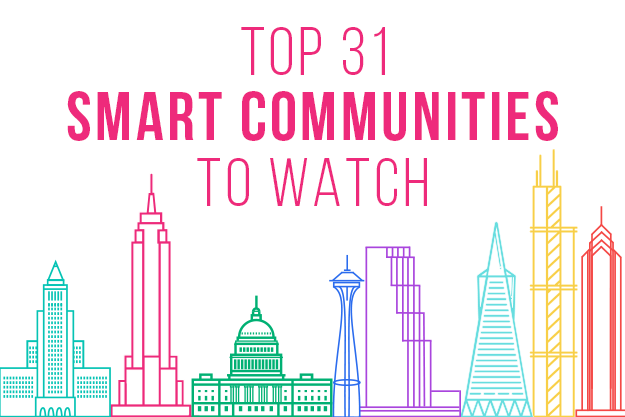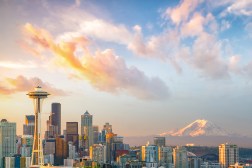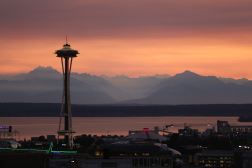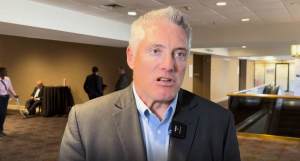

San Antonio
Centralized under the citys SA Tomorrow plan, San Antonio emphasizes transportation, sustainability and digital connected living. In addition to the plan, the Texas city partnered with the Smart Cities Council to host a workshop designed to refine collaboration among city agencies working on smart cities initiatives.
Last year, Chief Innovation Officer Jose De La Cruz told StateScoop that San Antonio’sefforts would cost approximately $8 million in 2017, with projects involvingthe Internet of Things, sustainability and transportation. Earlier this year, the city announced a new 311 app driven by social media and gamification with local startup Cityflag to help connect its civic tech and smart city communities.
Collaboration is key in any smart city, a San Antonio representative told StateScoop in an email. We are working with our utilities, transit organizations, nonprofits, academic institutions, military, tech community and private businesses. We want to ensure that all of our key stakeholders are a part of the process and lend their voice to what kind of a smart city San Antonio will be.
The city has alsotapped into the public Wi-Fi kiosk trend that has spread out of New Yorks LinkNYC project, which is expected to provide both a baseline of connectivity and educational use cases as the smart city space matures.

San Diego
San Diego’s projects make it a contender not only nationally, but on the global smart city scene. In what would be one of the largest Internet of Things (IoT) projects in the world, Mayor Kevin Faulconer announced plans in February to invest in a network that will dot the city with more than3,200 sensorsto monitor everything fromtraffic and air qualityto pedestrian safety.
Faulconer said his intention for the massive IoT project is to design a new system that can deliver actionable, real-time intelligence for city departments on services while providing residents greater transparency. General Electric is spearheading the work and reports plans to addsensors as it upgrades the citys street lights with a smart LED lighting system. The possibilities for the network are vast, with ample room to exploration other related IoT projects. If all goes well, Falconer plans to add an additional 3,000 sensors.
Fostering innovation and improving infrastructure are important to enhancing the lives of all San Diegans, Faulconer said in arelease. This new technology will give the city and developers the opportunity to make our neighborhoods safer and smarter.
But with upgrades come new responsibilities. In preparation of the IoT network, the city has enhanced itscybersecurityprotocols. In 2016, former Chief Information Security OfficerGary Hayslip told StateScoophe had begun testing different methods for protecting sensitive data. The new IoT network should be thought of as critical infrastructure, he said, and so the city should be proactive in protecting it. Today, San Diego is just beginning to test the technology, but reports it already intends for some of the data to be channeled into its open data portal and into future apps for city services.

San Francisco
As it is with manydigital advances, San Francisco is a trendsetter in the smart city arena. It was rated among the top smart cities in the world by the London-based firm Machina Research in 2016, and whether it’s creating civic apps, deploying sensorsor publishingopen data, San Francisco is a leader.
San Francisco stands out for its Internet of Things network,which is gaining momentum, and a Startupin Residence program that has grown to encompass other cities and counties in the Bay Area.In 2015, the city partnered with Sigfox to create its IoT Network, an endeavor that has blossomed into a system that provides IoT connectivity for local businesses and the city itself. Among several pilots in the worksis a partnership between the San Francisco Public Utility Commission (PUD) and Ayekka, a company specializing in water and sewage flows. With its IoT network, the city was able to upgrade outdated devices that were hiking service costs,and replace daily reports with real-time updates.
The citysStartup in Residenceprogram has expanded with partnerships from nearby California cities like Oakland, San Leandro, and West Sacramento. Mayor Ed Lee and Chief Innovation Officer Jay Nath founded the program in 2014 to embed tech startup in city departments. The vision was to develop a program that gave the city new IT from civic tech startups while giving entrepreneurs feedback to improve their services and real-world use cases for marketing.
I launched the Startup in Residence program to promote the collaboration of startups and local governments, to create a better quality of life for our residents, Lee said last year.
A sample of the innovative ideas to spring from the program is an IoT solution to help the blind navigate the San Francisco International Airport, a volunteer managementsystemfor the San Francisco Fire Department, and anappthat simplifies the application process for potential foster care parents.

San Jose, California
San Jose’s smart city efforts exemplify the driving force behind the national movement. According to Chief Information Officer Rob Lloyd, it’s not the technology they’re interested in, but the creation of a city that is safe, inclusive, sustainable, and user-friendly.
The projects the California city is undertaking now will make the ways that people commute, transport goods and manage emergencies today unrecognizable to coming generations of Americans, Lloyd reckoned in an email to StateScoop.
A partnership between the city and Dell EMC and NTT Group along with partnersVMware, Pivotaland Intel is delivering several new smart city concept projects. A smart cities platform would help the city manage an array of projects and connection types across its portfolio of priorities. Edge computing will assist in managing the triggers, analytics and events that prompt city action. And a model policy will establish the framework for how San Jose uses its sensors and collected data toimprove its communities.
A recent contract with AgreeYa is allowing the city to develop a predictive data aggregation engine for police and fire activities, while a partnership with East Side Union High School District expands public Wi-Fi. A contract awarded to PricewaterhouseCoopers for the city’s Digital Inclusion and Broadband Strategy (DIBS) additionally supported to the tune of $200,000 by The Knight Foundation establishes a governance model for sustainability and growth of one of the city’s most valuable digital assets.
An RFI for self-driving vehicles published in early June could help the city meet the goals of its Vision Zero initiative, while a partnership with Facebook will allow San Jose to serve asa demonstration city for the social media giant’s Terragraph gigabit wireless backhaul technologies.
As the city pursues these projects, “functionally siloed views of city assets” challenge growth, Lloyd said.
“[There’s a] lack of policy maturity along with heightened sensitivities and politics affecting use of sensor technologies,” Lloyd said. “[There’s] a closed proprietary approach of most smart city [and Internet of Things] vendor offerings e.g., smart light poles, smart manholes, smart trash cans and never shall they meet.”
But the platform now being pursued by San Jose, he said, will likely drive a period of rapid growth in which a new generation of capabilities will emerge.

San Leandro, California
San Leandro is a city in the middle of great transformation as it turns from an industrial and manufacturing center into a digital hub for the tech industry. The Bay Areacity has laid the foundation for this change through a fiber loop to connect businesses with high-speed internet, and via infrastructure investments that insert digital tools and sensors within the city landscape.
Tony Batalla, San Leandros information and technology manager, said three major changes are under development in 2017, with the first focused on analytics. The city in the process of designing a new performance and operations dashboard with help from the LotaData, a startup that helped the city to manage its recreation data through the 2016 Bay Area Startups in Residence program.
Since then, weve expanded the platform to connect to datasets from our 311 program My San Leandro and crime data, Batalla said. The vision is to build a citywide data analytics dashboard that connects to multiple city datasets and can analyze data cross-departmentally.
When complete, the city is expected to be able judge its performance at a glance, adapting tooperational disruptions and changes.
At an executive level, you would be able to see across multiple departments, Batalla said. In addition, we are working on an open data portal to give the public access to some form of this.
Increasing the citys digital services, the two other projects on tap this year are upgrades to San Leandros public Wi-Fi System and further installations for the citys smart LED lighting project, expected to save millions in energy costs while reducing emissions from fossil fuel energy plants. Other Internet of Things services will piggyback off the lighting systems connectivity, as San Leandro considers projects like smart trash bins and integrated smart parking systems.

Seattle
Seattle isnt taking any chances on its smart city efforts. The city is uniquely searching for a smart city coordinator, an official who would help the technology department develop a roadmap and ensure that any possibility of recreating government’s silos and erecting “a dumb smart city” are averted. The incomingofficial would ensure the new technologiesbeing pursued aresustainable, secure and supportable, said Seattle Digital Engagement Director Jim Loter.Theymust also, he added,preservethe public’s privacy through collection, storage and publication of data that adheres to the city’s privacy, surveillanceand social equity agendas.
“We currently lack a comprehensive ‘one city’ approach to being a smart city, which is something that the smart city coordinator will help us achieve,” Loter wrote StateScoop in an email. “One specific ‘gap’ lies between the citys plans and the knowledge of the community about this technology. We need to demonstrate that there is real value to these technologies that can tangibly and measurably improve the quality of life for people living in and visiting Seattle. We can only do that by engaging with the public and developing a shared vision.”
Seattle is a national leader for its adoption of sensor technologies used to monitor things like ground temperature, traffic, parking, structural integrity of critical infrastructureand rainfall as officials continue to probe the market for new projects and partnerships. In January, the city published a request for information (RFI) to gauge interest from the private sector and nonprofits to partner on technologies including wireless broadband, drones and other smart city devices. In May, Seattle became one of three cities to enter a pilot project with DataKind and Microsoft that uses machine learning and predictive analytics to show where vehicles most frequentlycollide and why. And in February, Seattle became one of 11 cities where Verizon will lay the foundational infrastructure for smart city connectivity in the form of 5G wireless networks.

Washington, D.C.
For the nations capital, one key theme runs through smart city initiatives: inclusion.
Spearheaded by Archana Vemulapalli, the citys chief technology officer, most of Washington, D.C.s smart city efforts fall under the Smarter DC governance model. The model provides for an interagency, interdisciplinary team that crosses all major stakeholder communities across the city government, citizens, academia and industry.
Smarter DC has already made dramatic changes in how Washington, D.C. approaches smart city concepts and technologies and is significantly impacting how new smart city initiatives are planned and deployed across the city, a representative from citys technologyteam told StateScoop in an email.
One of those smart city projects is PA 2040 an interagency collaboration designed to revamp the citys Pennsylvania Avenue corridor just blocks from the White House. The projects first phase delivered gigabit-speed Wi-Fi and intelligent lighting in the area,establishinga backbone for other smart city applications. D.C.is now planning its second phase, which will include smart parking, traffic inspections, environmental monitoring and water monitoring.
The cityboasts an “open by default” data policy, while its SmarterDC demo days provide an outlet topilot and showcase potential vendors for new smart city solutions.






